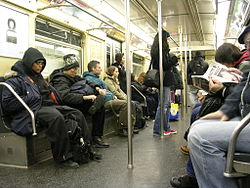R32 (New York City Subway car)
| R32 | |
|---|---|

|
|

Interior of an R32 car.
|
|
| In service | 1964-Present |
| Manufacturer | Budd Company |
| Built at | Philadelphia |
| Replaced | BMT Standard, BMT D Triplex |
| Constructed | 1964–1965 |
| Entered service | September 14, 1964 |
| Refurbishment | 1988–1990 |
| Scrapped | 2007 (GE-rebuilt cars) 2008 (Phase II cars) 2009-2010, 2013 (many Phase I cars) |
| Number built | 600 |
| Number in service | 222 (170 in revenue service during rush hours)/additional 10 in work service |
| Number preserved | 4 (additional 4 used for training) |
| Number scrapped | 360 |
| Formation | Married Pairs |
| Fleet numbers | 3350–3949 (3659 renumbered to 3348) |
| Capacity | 50 (seated) |
| Operator(s) | New York City Subway |
| Depot(s) |
207th Street Yard (102 cars) East New York Yard (120 cars) |
| Service(s) assigned |
– 20 cars (2 trains; PM rush) – 56 cars (7 trains, AM rush) |
| Specifications | |
| Car body construction | Stainless steel |
| Train length | 2 car train: 120.25 feet (36.65 m) 4 car train: 240.50 feet (73.30 m) 6 car train: 360.75 feet (109.96 m) 8 car train: 481 feet (147 m) 10 car train: 601.25 feet (183.26 m) |
| Car length | over coupler faces: 60 ft 3 in (18.36 m) |
| Width | 10 ft (3,048 mm) |
| Height | 12.08 ft (3,682 mm) |
| Platform height | 3.76 ft (1.15 m) |
| Entry | 3.76 ft (1.15 m) |
| Doors | 8 |
| Maximum speed | 55 mph (89 km/h) |
| Weight | 79,930 lb (36,260 kg) (post-rebuild) (70,000 lb or 31,751 kg when delivered) |
| Traction system | General Electric SCM 17KG192E3, DC propulsion system using GE 1257E1 motors or Westinghouse 1447JR (115 hp or 86 kW per axle) (retired R32GE cars used 115 hp or 86 kW 1257F motors, all cars originally had Westinghouse 1447JR motors, as do all remaining cars in service) |
| Acceleration | 2.5 miles per hour per second (4.0 km/(h·s)) |
| Deceleration | 3.0 miles per hour per second (4.8 km/(h·s)) (Full Service) 3.2 miles per hour per second (5.1 km/(h·s)) (Emergency) |
| Electric system(s) | 600 V DC Third rail |
| Current collection method | Contact shoe |
| Braking system(s) | WABCO RT2 SMEE braking system, A.S.F. simplex unit cylinder clasp (tread) brake |
| Safety system(s) | tripcock |
| Coupling system | Westinghouse H2C |
| Headlight type | halogen light bulb |
| Track gauge | 4 ft 8 1⁄2 in (1,435 mm) |
The R32 is a New York City Subway car model built from 1964 to 1965 by the Budd Company in Philadelphia for the IND/BMT B Division.
The R32s are numbered 3350–3949, but some cars have been re-numbered outside of this range or to different numbers in this range. They were the first cars to introduce all mylar route and destination rollsigns instead of the former cotton cloth or linen type rollsigns found on prior rail cars.
The R32s were the first mass-produced stainless steel cars built for the New York City Subway. Two previous Budd orders (the BMT Zephyr and the R11s) were limited production orders. The horizontally ribbed, shiny, and unpainted stainless exteriors of the R32s earned the cars the nickname Brightliners. The use of stainless steel reduced the weight of each car by over 4,000 pounds, when compared to previous models.
The R32 contract was divided into two subcontracts of 300 cars each: the R32As (cars 3650-3949) and R32s (cars 3350-3649). The R32As were funded through the proceeds of a revenue bond while the R32s were paid for out of the 1963–1964 New York City capital budget. The two subcontracts differed only in interior lighting; the R32As had interior lighting featuring backlit ad-signs.
In June 1963, the New York City Transit Authority contracted with Budd for 600 IND/BMT cars (300 pairs) to replace older equipment (cars that had exceeded the TA's 35-year limit of age), including the BMT D-type Triplex articulated cars and some of the BMT Standards. At the time, this was the largest railcar order ever placed in the United States for subway cars. The cars were ordered for $68,820,000, of which half was provided by New York City and half through the sale of bonds by the New York City Transit Authority. Budd had bid on previous contracts with the NYCTA, but had never won a City contract for a production run of cars until the R32s, as Budd built only stainless-steel equipment and the TA refused to allow a differential in competitive bids for this higher-quality construction.
...
Wikipedia
